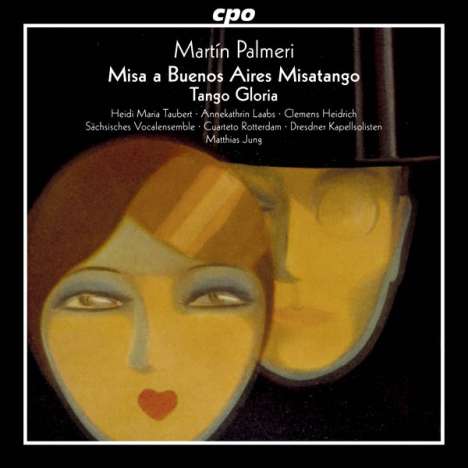Martin Palmeri: Misa a Buenos Aires Misatango auf CD
Misa a Buenos Aires Misatango
Herkömmliche CD, die mit allen CD-Playern und Computerlaufwerken, aber auch mit den meisten SACD- oder Multiplayern abspielbar ist.
+Tango Gloria
- Künstler:
- Heidi Maria Taubert, Annekathrin Laabs, Clemens Heidrich, Sächsisches Vocalensemble, Cuarteto Rotterdam, Dresdner Kapellsolisten, Matthias Jung
- Label:
- CPO
- Aufnahmejahr ca.:
- 2016
- Artikelnummer:
- 5173631
- UPC/EAN:
- 0761203509225
- Erscheinungstermin:
- 15.11.2016
Eine argentinische Tangomesse
Die Tangomesse von Martín Palmeri ist natürlicherweise inspiriert vom traditionellen Tango seines Heimatlandes, aber vor allem vom Tango Nuevo Astor Piazzollas. So entwickelte Piazzolla einen »Neuen Tango«, der nicht mehr als Tanzmusik sondern als Musik fürs Konzertpodium gedacht war, der zeitgenössische Formen und musikalische Entwicklungen aufgriff und so zu einer komplexen Kunstmusik wurde. Die 1996 von der »Sinfonica Nacional de Cuba« uraufgeführte »Misa a Buenos Aires« beweist gleichsam eindrucksvoll und unterhaltsam das Talent Palmeris, die stilistischen Merkmale des Tangos in seine Kompositionen einfließen zu lassen. Textgrundlage des Stückes ist das klassische katholische Messordinarium, wie es seit Jahrhunderten vertont wird.. Mit der Besetzung (Mezzosopran, gemischter Chor, Tangoquartett und Streichorchester) bleibt Palmeri nah an den authentischen Besetzungen der Tangoorchester seiner Heimat. Spannend ist dabei vor allem, wie phantasievoll er die Spielmöglichkeiten der Instrumente nutzt. Typische Techniken des Tango, dieses rhythmusbetonten Tanzes, bei dem auch die Melodieinstrumente percussiv als Impulsgeber verwendet werden, spielen dabei eine wichtige Rolle. Die herausragende Verwendung des Bandoneons – mal als singende Stimme, dann wieder als Rhythmusinstrument – garantiert dabei die »Tangoseele«. Auch Melodieführung, Harmonik und die rhythmischen Strukturen sind selbst von Laien als Tangostilmittel erkennbar. Mit großem melodischem Einfallsreichtum schöpft Palmeri die verschiedenen Klangfarben des Tangos passend zu den unterschiedlichen Charakteristiken der Messsätze aus. Das 2014, also gut 18 Jahre nach der Tangomesse uraufgeführte »Gloria« ist um einiges komplexer – sowohl satztechnisch als auch harmonisch – und lässt den gefälligen, manchmal an der Grenze zum Populärmusikalischen wandelnden Ton der Messe hinter sich. In allen Teilen bleibt jedoch auch hier die melodische und emotionale Ausdrucksvielfalt erhalten. Europäische Tradition und Tango werden auch hier auf kunstvolle, überzeugende Weise zusammengeführt.
Product Information
An Argentine Tango Mass
Martín Palmeri's tango mass is inspired by his native Argentina's traditional tango and in particular by Astor Piazzolla's tango nuevo. Piazzolla developed a »new tango« intended no longer as dance music but for the concert stage; by incorporating contemporary forms and musical developments it gave rise to a complex genre of art music. The Misa a Buenos Aires premiered by the Orquesta Sinfónica de Cuba in 1996 demonstrates Palmeri's impressive and equally entertaining talent for integrating stylistic features of the tango into his compositions. The textual basis of the work is the classical Catholic Ordinary of the Mass as it has been set to music for centuries. The scoring for mezzo-soprano, mixed choir, tango quartet, and string orchestra remains close to the authentic ensembles of the tango orchestras of Palmeri's native country. Here what is above all exciting is how imaginatively he employs the playing resources of the instruments. Typical techniques of the tango, this rhythmically emphatic dance in which the melody instruments are also used percussively to give impulses, play an important role here. The outstanding employment of the bandoneón, sometimes as a singing voice, then again as a rhythm instrument, here guarantees the preservation of the »tango soul.« Melodic leading, harmony, and the rhythmic structures are also recognizable as tango stylistic means to non-experts. It is with great melodic imaginative richness that Palmeri blends the various tone colors of the tango with the various characteristics of the individual parts of the mass. The Gloria, premiered in 2014, a good eighteen years after the tango mass, is of somewhat greater complexity – both in compositional technique and in harmony – and leaves behind the pleasant tone of the mass. In all of its parts, however, here too the melodic and emotional expressive variety remains. Here European tradition and the tango are brought together in a finely crafted and compelling manner.
Rezensionen
Concerti 01/2017: »Tango und sakrale Chormusik - Teufel und Weihwasser? Der Argentinier Martin Palmeri beweist mit seiner ›Misa e Buenos Aires‹ und mit Tango Gloria eindrücklich, dass die Fusion funktioniert. Das Ergebnis sind emotionale Offenbarungen, bei denen sich zwei Sphären gegenseitig bereichern, weil Palmeri in beiden etwas zu sagen hat. Zum Klingen gebracht mit glänzend aufgelegten, inspirierten, fein gestaltenden Kräften und alles souverän zusammengehalten von Dirigent Matthias Jung.«Disk 1 von 1 (CD)
Misa a Buenos Aires ”Misatango” (Messe)
-
1 Kyrie
-
2 Gloria
-
3 Credo
-
4 Sanctus
-
5 Benedictus
-
6 Agnus Dei
Tango Gloria
-
7 Gloria in excelsis Deo
-
8 Et in terra pac hominibus
-
9 Laudamus te
-
10 Gratias agimus tibi
-
11 Propter magnam
-
12 Domine deus, rex coelestis
-
13 Domine fili unigenite
-
14 Domine Deus, Agnus Dei
-
15 Qui tollis peccata mundi
-
16 Qui sedes ad dexteram patris
-
17 Quoniam tu solus sanctus
-
18 Cum sancto spiritu
Mehr von Martin Palmeri











